Apple's 11-inch MacBook Air (Core i7 1.8GHz) Review Update
by Anand Lal Shimpi on August 1, 2011 6:08 PM EST- Posted in
- Mac
- Apple
- Intel
- Core i7
- Sandy Bridge
- MacBook Air
Last week we published our review of the new 2011 MacBook Air. Both the 11 and 13-inch models ship with ultra low-voltage (ULV) dual-core Sandy Bridge CPUs, a first for the lineup. Also another first for the lineup is the fact that you can now get equally specced CPUs in both models. In theory you'd be able to have the same performance regardless of chassis size.
The table below highlights the three CPUs available on the new MBAs:
| 2011 Apple MacBook Air CPU Comparison | |||||
| 1.6GHz Core i5 | 1.7GHz Core i5 | 1.8GHz Core i7 | |||
| Available in | 11-inch (default) | 13-inch (default) | high-end 11-inch (option) high-end 13-inch (option) |
||
| Intel Model | Core i5-2467M | Core i5-2557M | Core i7-2677M | ||
| Cores/Threads | 2/4 | 2/4 | 2/4 | ||
| Base Clock Speed | 1.6GHz | 1.7GHz | 1.8GHz | ||
| Max SC Turbo | 2.3GHz | 2.7GHz | 2.9GHz | ||
| Max DC Turbo | 2.0GHz | 2.4GHz | 2.6GHz | ||
| L3 Cache | 3MB | 3MB | 4MB | ||
| GPU Clock | 350MHz / 1.15GHz | 350MHz / 1.2GHz | 350MHz / 1.2GHz | ||
| Quick Sync | Yes | Yes | Yes | ||
| AES-NI | Yes | Yes | Yes | ||
| VT-x | Yes | Yes | Yes | ||
| VT-d | No | Yes | Yes | ||
| TDP | 17W | 17W | 17W | ||
The 1.8GHz Core i7 is offered as an upgrade to both the 11 and 13-inch MacBook Air. With much higher max turbo speeds and another megabyte of L3 cache, it's clear this is going to be a big upgrade over the standard 11-inch Air.
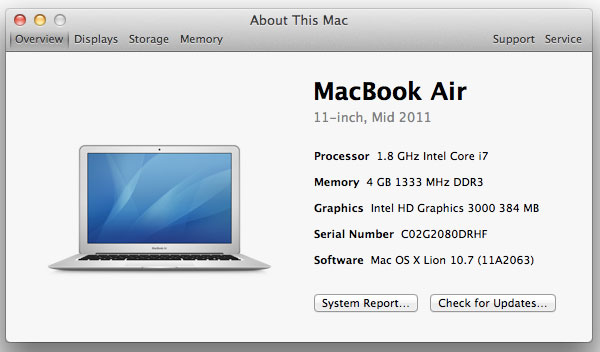
Last week we got our hands on one of these upgraded 11-inch models to find out just how much faster it is. We also wanted to find out what sort of an impact the faster CPU would have on the 11's thermals and battery life. It just so happens that our upgraded 11 gave us more than just that to investigate.
The Panel Lottery
For commodity parts within its systems Apple typically sources from two different vendors. This is done to avoid shortages due to a single component vendor. It also puts Apple in a good negotiating position. The MacBook Air is no different. Each model (11 & 13-inch) ships with one of two panels. Word on the street is that one of those panels is better than the other. It was time to find out if that's the case.
If you want to know who makes the display in your Mac and Apple hasn't overridden the EDID information from the panel simply open up terminal and execute this string:
ioreg -lw0 | grep IODisplayEDID | sed "/[^<]*</s///" | xxd -p -r | strings -6
The output will look something like this:
LP116WH4-TJA3
Color LCD
The first line is the panel's model number. Typically a quick Google search of the first few characters will give you the manufacturer's name. In this case, the LP116WH4 is made by LG Philips (hence the LP prefix). This happens to be the panel in the 11-inch Core i7 MacBook Air I just got my hands on. If you read my original review of the 2011 MBAs you'll know that both of the systems I tested there had panels by a different manufacturer:
LTH133BT01A03
LTH116AT01A04
The LT prefix on both of those part numbers implies Samsung is the OEM. The current working theory is that the LG panel in the new MacBook Air is somehow worse than the Samsung panel. Given the vast difference we saw in SSD performance between the Samsung and Toshiba drives, is it possible that Apple has allowed a similarly large gap to form between LCD vendors? Not so much:

The LG panel is slightly dimmer than the Samsung panel I originally tested.
Although you don't get peak brightness, you do get lower black levels on the LG panel:


The combination of the two actually gives us a healthy boost in max on/off contrast:
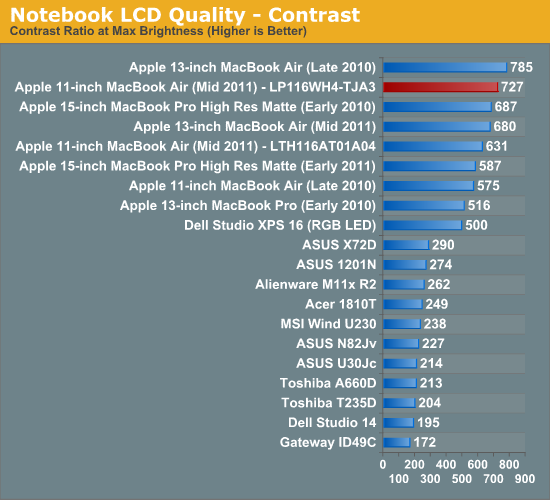
In normal usage I never noticed the increase in contrast, nor did I feel the panel was any dimmer, but there is technically an advantage here.

Color accuracy is also slightly better on the LG panel, although this small of a difference is basically impossible to notice.
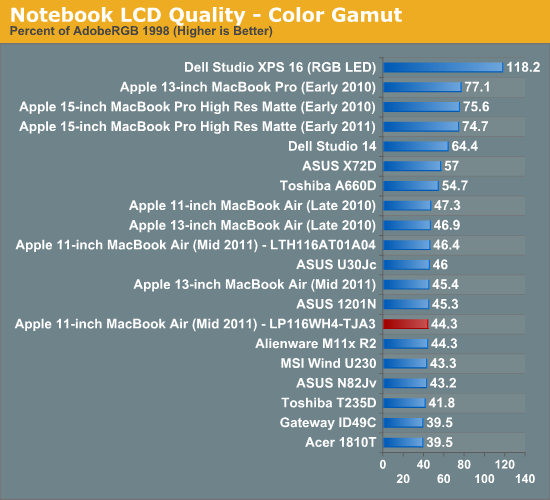
Perhaps due to backlight differences the LG panel does have a narrower color gamut.
Apple calibrates all of its systems with integrated displays before shipment so the LG panel has a similar white point to the earlier Samsung panel we tested (6700 - 6800K):

Based on these numbers alone I don't see any reason to believe that the LG panel in the new MacBook Air is any worse than the Samsung panel. However I do believe that there may be an explanation for the perceived inferior quality of the LG panel. The LG panel exhibits vertical color/contrast shift more readily than the Samsung panel. Unfortunately I don't have them both here to show you a side by side comparison but the LG panel seems to be slightly more sensitive to vertical viewing angle. As I mentioned in our original 2011 MacBook Air review, the 11 is a particularly tough system to use due to the height of its display. In order to get perpendicular line of sight to the display you need to tilt the display back and your head down. If you're off by just a few degrees you'll start to see color/contrast shift. On the LG panel that classic TN panel distortion seems to come a bit sooner than on the Samsung panel.
The issue was most noticeable to me when I had the 11 on a desk rather than on my lap. While it was particularly bothersome when I first got it, I've since become used to the display. Obviously these machines are expensive enough that I believe you should be happy with your purchase, but from my perspective the two panels are close enough that it's not worth losing sleep over. Both the LG and Samsung panels are TN panels. They may have better display characteristics than your typical cheap TN panel, but they still have the same viewing angle limitations as other TN panels. Both panels exhibit the same issues, the LG may just show them off a few degrees sooner.
The bigger problem for some is that the 11-inch MacBook Air has the highest pixel density of anything Apple ships:
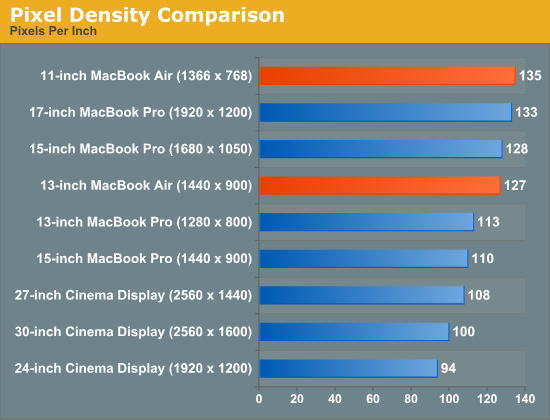
While I'm glad Apple opted for a high resolution 11-inch display, not everyone will find it easy to read. This isn't something that varies with panel type, it's just a side effect of having a small display with a high pixel density.


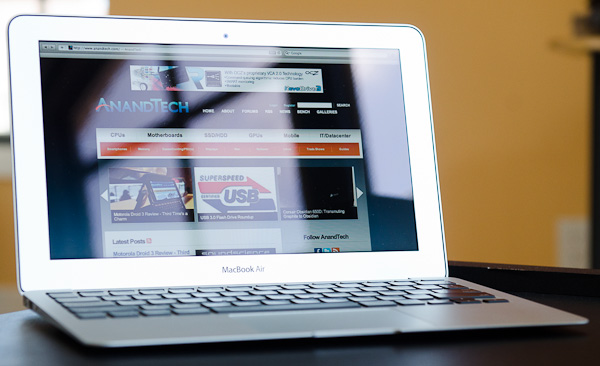

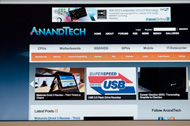
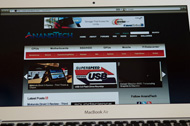








55 Comments
View All Comments
jnmfox - Monday, August 1, 2011 - link
"If you're buying an 11-inch MacBook Pro and care about performance, the 1.8GHz CPU upgrade is worth it."An 11-inch MBP could be sweet though....
CharonPDX - Monday, August 1, 2011 - link
For $50, you get an 11" that is faster than the base 13", and you're giving up an SD slot and some resolution, in favor of a smaller/lighter chassis and better performance.To me, it's a no-brainer. If I were in the market to replace my notebook right now (aka: if my MacBook Pro were to die in the next couple months,) I would immediately get an 11" Air upgraded to i7.
h00ligan76 - Monday, August 1, 2011 - link
You also give up battery life, and that screen space is palpable to some. Anyone needing photo editing on the go is going to benefit from added screen, sd (potentially) and battery life...I agree for some it's a no brainer.. just which way depends on the person :)
vrusso87 - Monday, August 1, 2011 - link
I was just at the web store and noticed something characteristically Apple - you can't upgrade the base 11-inch (64GB) or 13-inch (128GB) Air models to the i7. You have to swallow the $200-$300 price premium for the larger SSD before you can shell out another $100-$150 for the i7.Irksome.
blue_fireball_eater - Monday, August 1, 2011 - link
Is how fast the OWC Aura drive run in these machines. I have the Samsung drive, so should I even consider upgrading to a Sandforce drive, or just wait for inevitable Sandforce 2000 version to come out?tipoo - Monday, August 1, 2011 - link
I'd still like to see decible readings of these at load, I see them in other Anandtech laptop reviews but for some reason never on Mac's.aladdin68 - Monday, August 1, 2011 - link
does the fact that the 11 in i7's run a little hotter likely to have any impact on their overall lifespan as compared to the 11 in i5's?narlzac85 - Monday, August 1, 2011 - link
I wish there was a comparison review of the base $999 model, because I think a lot of people are going to buy that one not realizing that they are only getting 2GB of memory and its not able to be upgraded. Which to me would seem like buying a completely crippled system. Wasn't 2GB determined to be the absolute minimum for OSX way back in Leopard? Bad move by Apple. They should have ditched thunderbolt on the base model and increased the memory. Considering more ram benefits everyone and thunderbolt benefits very few people at the moment. Or they could have just eaten the cost of the 2 extra GB if they are really trying to push Thunderbolt.h00ligan76 - Monday, August 1, 2011 - link
My air boots requiring 1.25 GB - before running anything. It starts paging pretty fast even with 4gb the minute lightroom and photoshop get opened.At this point, for anything other than an iPad with a keyboard, I wouldn't be buying the 2gb model.
hechacker1 - Tuesday, August 2, 2011 - link
I too noticed as soon as I upgraded to Lion, even with 4GB it started to swap out to disk.I'm assuming they changed the memory management in Lion compared to Snow Leopard, because it rarely swapped in SL.
So I went out to buy 8GB, and now it doesn't swap. But it does somehow consume 7.5GB with what I assume are caches (even when I'm not running lots of programs).